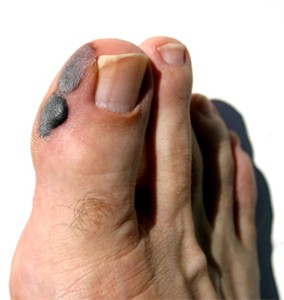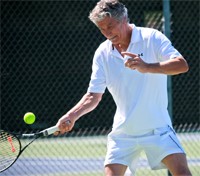|
Blisters: Prevention and Treatment
Author:
Stan Reents, PharmD
Original Posting:
04/08/2008 08:31 AM
Last Revision: 12/10/2018 05:36 AM

Blisters occur commonly. In a recent study, 69% of soldiers developed blisters during a 20-km march (Brennan FH. 2002).
And they can occur anywhere. The foot is the most common location. But, tennis players can get them on their hands, and I know a triathlete who got saddle sores from her bike. Blisters can bring your activity to a complete halt. Worse, it may be days before your foot, hand, etc. can tolerate performing the same activity again.
In this article, I will give you some pointers on how to deal with them.
WHY DO BLISTERS FORM?
A blister -- or, to use the more medical term, "friction blister" -- is a visible expression of the body's physiologic response to repetitive chafing. Although blisters are something that we don't want, the body doesn't know that. Blisters are simply another example of the "general adaptation response", a process first described by Hans Selye, MD, when he was a medical student back in the 1930's. Just like your muscles enlarging in response to weight-training, or, your VO2max improving in response to regular aerobic training, your skin is responding to a new stimulus. The formation of a blister is the first step in creating a callus. A callus, in turn, is the body's attempt to create a protective barrier within the skin.
PREVENTION
It's 100 times better to prevent a blister from ever developing than to try and treat it so you can continue performing. Here are some tips regarding prevention:
• Wear good quality, thick socks. When blisters occur on the foot, the cause of the chafing is your shoe. Wearing thick socks will generally do a decent job of protecting your skin. Some athletes wear 2 pairs of socks at the same time. But, avoid cheap cotton tube socks. Look for socks by Thermolite, Thorlo, and WigWam. (Is one type of fabric better than another?...see the Q/A below.) Once your socks get saturated with sweat, change them. Damp skin becomes macerated, making blisters more likely.
• Make sure your shoes fit properly. Don't underestimate how important it is to get properly-fitting shoes. Just doing this may prevent blisters from forming.
• Don't wear brand new shoes just prior to beginning an important event! Even though you have those new shoes that fit perfectly, don't wait until a big race or the district tennis tournament to wear them. Break them in first! Here's my story:
Several years ago, I made plans to hike the north rim of the Grand Canyon. I went to this terrific outdoor gear store in Orlando, FL (Travel Country Outdoors, www.TravelCountry.com) for a shoe-fitting. After 2 hours of measurements and trying on shoes, I was certain I had some hiking shoes (and socks!) that would guarantee that I wouldn't have any problems with my feet. I was wrong. By the end of the first day of hiking, I had blisters on the inside edge of both heels. The hike back up the next day was miserable. So, what happened? Even though I wore thick socks, these shoes hadn't been broken in....it was the first time I had worn them.
• Use a protective barrier. If thick socks don't help, try using a topical product like Dr. Scholl's Moleskin Plus Pads. This OTC product has an adhesive on one side. You can cut it to the size and shape you need, and then place it directly over the area you want to protect. Now, if your shoe rubs, it will rub against this pad and not your skin. Band-Aid (www.Band-Aid.com) also has a product called "Tough Strips®" which claim to be waterproof.
• Apply a lubricant. Although somewhat embarrassing, many distance runners and triathletes sometimes suffer from chafed nipples. Think about it: even though the fabric of their jersey is light-weight, it is rubbing across that area continuously for 3-4 hours. Many of these athletes use a product called Body-Glide (www.BodyGlide.com). But, you can also use plain ol' Vaseline. You can use lubricants on your feet, too. The Walking Site (www.TheWalkingSite.com) recommends something you can make yourself: A&D ointment + Vaseline + vitamin E cream + aloe vera cream. Obviously, this strategy won't work for tennis players and rowers who get blisters on their hands.
• Trim your toenails. A sharp edge on a toenail rubbing against the toe next to it can create a blister or sore spot in less than 30 minutes.
TREATMENT
OK, so what do you do if a blister has already formed? Here are some tips:
• Moleskin pads: Try using Dr. Scholl's Moleskin Pads. But, unlike "Prevention" (above), where the pad is applied directly over the area you want to protect, in this case, cut a hole in the center of the pad and place the Moleskin around the blister. If you stick Moleskin directly on top of a formed blister, you may tear it open when you remove the pad. Not only is this painful, but it can increase the chances for infection.
• Antibiotics: According to a review from Sports Medicine, there is no evidence that topical antibiotics speed healing (Knapik JJ, et al. 1995).
• Drainage: (see Q/A below).
QUESTIONS
Q: Does it make any difference if I wear cotton socks, or socks made from acrylic fabrics?
ANSWER: In 1990, the California College of Podiatric Medicine conducted a study of 35 distance runners. They found that socks made from 100% acrylic fibers resulted in fewer and smaller blisters compared to socks made from natural cotton (Herring KM, et al. 1990). Several years later, a literature review published in the journal Sports Medicine stated that "a thin polyester sock, combined with a thick wool or polypropylene sock that maintains its bulk when exposed to sweat and compression, reduced blister incidence in Marine recruits." (Knapik JJ, et al. 1995). Certainly, socks have changed a lot in the last 15-20 years, but it does seem like synthetic fabrics are better choices than cotton.
Q: Should the fluid inside a fresh blister be drained?
ANSWER: If this can be done carefully, and, using antiseptic conditions, it appears the answer is "yes". A review from the journal Sports Medicine states "clinical experience suggests draining intact blisters and maintaining the blister roof results in the least discomfort and may reduce the possibility of infection." (Knapik JJ, et al. 1995).
FOR MORE INFORMATION
A web site with good information on foot care for hikers is The Walking Site (www.TheWalkingSite.com).
For information on simple first aid products for blisters, check out the web sites for Band-Aid® (www.Band-Aid.com) and Spenco (www.Spenco.com).
Readers may also be interested in these reviews:
(And, for those of you who just have to know whose big toe that is in the photo at the top of this story, yes, it's mine. It's the result of playing nearly 2 hours of tennis. Even though I was wearing well-worn shoes, and thick socks, I didn't lace up my shoes tightly enough.)
EXPERT HEALTH and FITNESS COACHING
Stan Reents, PharmD, is available to speak on this and many other exercise-related topics. (Here is a downloadable recording of one of his Health Talks.) He also provides a one-on-one Health Coaching Service. Contact him through the Contact Us page.
REFERENCES
Brennan FH. Managing blisters in competitive athletes. Curr Sports Med Rep 2002;1:319-322. Abstract
Herring KM, Richie DH. Friction blisters and sock fiber composition. A double-blind study. J Am Podiatr Med Assoc 1990;80:63-71. Abstract
Knapik JJ, Reynolds KL, Duplantis KL, et al. Friction blisters: pathophysiology, prevention, and treatment. Sports Med 1995;20:136-147. Abstract
ABOUT THE AUTHOR

Stan Reents, PharmD, is a former healthcare professional. He is a member of the American College of Lifestyle Medicine (ACLM) and a member of the American College of Sports Medicine (ACSM). In the past, he has been certified as a Health Fitness Specialist by ACSM, as a Certified Health Coach by ACE, as a Personal Trainer by ACE, and as a tennis coach by USTA. He is the author of Sport and Exercise Pharmacology (published by Human Kinetics) and has written for Runner's World magazine, Senior Softball USA, Training and Conditioning and other fitness publications.
Browse By Topic:
exercise and health, sports medicine
Copyright ©2026 AthleteInMe,
LLC. All rights reserved.
|